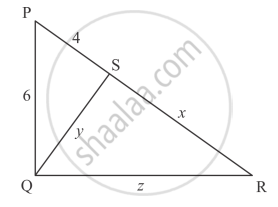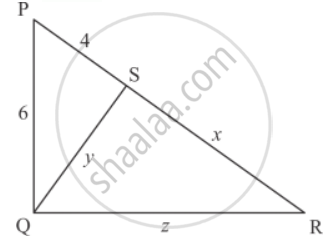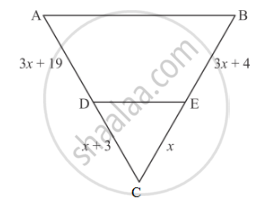Advertisements
Advertisements
प्रश्न
In each of the figures given below, an altitude is drawn to the hypotenuse by a right-angled triangle. The length of different line-segment are marked in each figure. Determine x, y, z in each case.

उत्तर
Δ PQR is a right triangle, right angled at Q

`6+z^2 = (4+x)^2`
`6+z^2=16+x^2+8x`
`z^2-x^2-8x=16-36`
`z^2-x^2-8x=16-36`
`z^2-x^2-8x=-20`......(1)
Δ QSP is a right triangle right angled at S
`QS^2+PS^2=PQ^2`
`y^2+4^2=6^2`
`y^2+16=36`
`y^2=36-16`
`y^2=20`
`y=sqrt20`
`y=sqrt(2xx2xx5)`
`y=2sqrt5`
Δ QSR is a right triangle right angled at S
`QS^2+RS^2=QR^2`
`y^2+x^2=z^2`..........(2)
Now substituting `y^2+x^2=z^2` in equation (i) we get
`y^2+x^2-x^2-8x=-20`
`20-8x=-20`
`-8x=-20-20`
`-8x=-40`
`x=40/8`
`x=5`
Now substituting ` x = 5` and `y^2=20` in equation (ii) we get
`y^2+x^2=z^2`
`20+5^2=z^2`
`20+25=z^2`
`45=z^2`
`sqrt(3xx3xx5)=z^2`
`3sqrt5=z`
Hence the value of x, y and z are `5,2sqrt5,3sqrt5`
APPEARS IN
संबंधित प्रश्न
What values of x will make DE || AB in the given figure?

In ∆ABC, points P and Q are on CA and CB, respectively such that CA = 16 cm, CP = 10 cm, CB = 30 cm and CQ = 25 cm. Is PQ || AB?
In ∆ABC, P and Q are points on sides AB and AC respectively such that PQ || BC. If AP = 4 cm, PB = 6 cm and PQ = 3 cm, determine BC.
In ∆ABC, the bisector of ∠A intersects BC in D. If AB = 18 cm, AC = 15 cm and BC = 22 cm, find BD.
ABCD is a trapezium in which AB || DC. P and Q are points on sides AD and BC such that PQ || AB. If PD = 18, BQ = 35 and QC = 15, find AD.
If ∆ABC and ∆DEF are two triangles such that\[\frac{AB}{DE} = \frac{BC}{EF} = \frac{CA}{FD} = \frac{3}{4}\], then write Area (∆ABC) : Area (∆DEF)
In an equilateral triangle ABC if AD ⊥ BC, then AD2 =
In the given figure the measure of ∠D and ∠F are respectively

If ABC is an isosceles triangle and D is a point of BC such that AD ⊥ BC, then
In an isosceles triangle ABC if AC = BC and AB2 = 2AC2, then ∠C =
